
Mecklenburg-Vorpommern ; also known by its anglicized name Mecklenburg–Western Pomerania, is a state in the north-east of Germany. Of the country's sixteen states, Mecklenburg-Vorpommern ranks 14th in population; it covers an area of 23,213 km2 (8,963 sq mi), making it the sixth largest German state in area; and it is 16th in population density. Schwerin is the state capital and Rostock is the largest city. Other major cities include Neubrandenburg, Stralsund, Greifswald, Wismar, and Güstrow. It was named after the two regions of Mecklenburg and Vorpommern, and its name means the "nearer part of Pomerania", with the rest now lying in Poland.
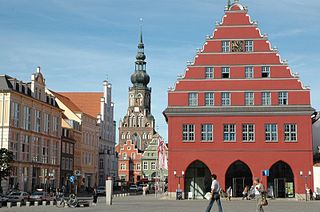
Greifswald, officially the University and Hanseatic City of Greifswald is the fourth-largest city in the German state of Mecklenburg-Western Pomerania after Rostock, Schwerin and Neubrandenburg. In 2021 it surpassed Stralsund for the first time, and became the largest city in the Pomeranian part of the state. It sits on the River Ryck, at its mouth into the Danish Wiek, a sub-bay of the Bay of Greifswald, which is itself a sub-bay of the Bay of Pomerania of the Baltic Sea.

Neubrandenburg is a city in the southeast of Mecklenburg-Vorpommern, Germany. It is located on the shore of a lake called Tollensesee and forms the urban centre of the Mecklenburg Lakeland.

Poel or Poel Island, is an island in the Baltic Sea. It forms the natural northern and eastern boundaries of the Bay of Wismar on the German coast. The northern coast of the island is also on the south side of the large gulf known as the Bay of Mecklenburg, which Wismar Bay enters into. Insel Poel thus forms on its northern side the unofficial latitude of the northern boundary of the Wismar Bay.

Brick Gothic is a specific style of Gothic architecture common in Northeast and Central Europe especially in the regions in and around the Baltic Sea, which do not have resources of standing rock. The buildings are essentially built using bricks. Buildings classified as Brick Gothic are found in Belgium, Netherlands, Germany, Poland, Lithuania, Latvia, Estonia, Kaliningrad, Denmark, Sweden and Finland.

Lehnin Abbey is a former Cistercian monastery in Lehnin in Brandenburg, Germany. Founded in 1180 and secularized during the Protestant Reformation in 1542, it has accommodated the Luise-Henrietten-Stift, a Protestant deaconesses' house since 1911. The foundation of the monastery in the newly established Margraviate of Brandenburg was an important step in the high medieval German Ostsiedlung; today the extended Romanesque and Gothic brickstone buildings, largely restored in the 1870s, are a significant part of Brandenburg's cultural heritage.

Morschen is a municipality in the Schwalm-Eder district of Hesse, Germany. and Morschen is a German word and is the imperative form of the verb "morschen," which means "to become rotten" or "to decay." However "morschen" can also be used as a friendly morning greeting, similar to "good morning" in English, especially in certain dialects or informal contexts. So, depending on the context, "morschen" can have different meanings.
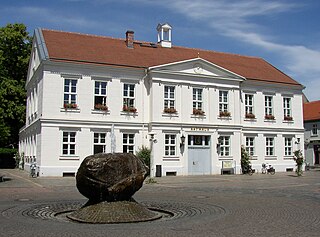
Pritzwalk is a town in the district of Prignitz, in Brandenburg, Germany. It is situated 20 km west of Wittstock, and 33 km northeast of Wittenberge. The river Dömnitz flows through Pritzwalk.

Kühlungsborn is a Seebad town in the Rostock district, in Mecklenburg-Vorpommern, Germany. It is situated on the Baltic Sea coast, 11 km northwest of Bad Doberan, and 25 km northwest of Rostock.

Tribsees is a municipality in the Vorpommern-Rügen district, in Mecklenburg-Vorpommern, in north-eastern Germany. It is situated 33 kilometres (21 mi) southwest of Stralsund, and 40 kilometres (25 mi) east of Rostock.

The architecture of Germany has a long, rich and diverse history. Every major European style from Roman to Postmodern is represented, including renowned examples of Carolingian, Romanesque, Gothic, Renaissance, Baroque, Classical, Modern and International Style architecture.

Bollewick is a municipality in the Mecklenburgische Seenplatte district, in Mecklenburg-Vorpommern, Germany. It is administered by the Röbel-Müritz office in the city of Röbel / Müritz. The municipality Bollewick includes the villages Nätebow, Spitzkuhn and since 7 June 2009, Kambs and Wildkuhl.

Vollrathsruhe is a municipality in the Mecklenburgische Seenplatte district, in Mecklenburg-Vorpommern, in north-eastern Germany.
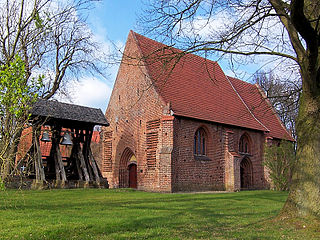
Alt Meteln is a municipality in the Nordwestmecklenburg district, in Mecklenburg-Vorpommern, Germany.
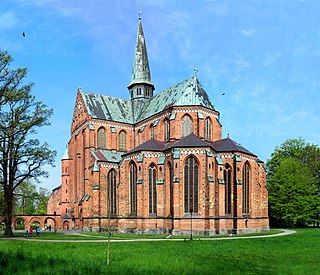
The Doberan Minster is the main Lutheran Church of Bad Doberan in Mecklenburg, Germany. Close to the Baltic Sea and the Hanseatic city of Rostock, it is the most important religious heritage of the European Route of Brick Gothic. It is the remaining part of the ex-Cistercian Doberan Abbey, dedicated in 1368. The first abbey in Mecklenburg, founded in 1171, which was also used as the burial site for the regional rulers, became important both politically and historically. Through the activities of its inhabitants, the abbey greatly contributed to the cultural and economic development of Mecklenburg and became the centre of Christianity in this region.

In the area of present-day Mecklenburg-Vorpommern, Germany, up to 5,000 megalith tombs were erected as burial sites by people of the Neolithic Funnelbeaker (TRB) culture. More than 1,000 of them are preserved today and protected by law. Though varying in style and age, megalith structures are common in Western Europe, with those in Mecklenburg-Vorpommern belonging to the youngest and easternmost—further east, in the modern West Pomeranian Voivodeship of Poland, monuments erected by the TRB people did not include lithic structures, while they do in the south (Brandenburg), west and north (Denmark).

Sankt Ols Kirke, also known as Olsker Church, is a 12th-century round church located in the village of Olsker, 4 km (2.5 mi) south of Allinge on the Danish island of Bornholm. Built in the Romanesque style and reaching three storeys high, it has from the beginning consisted of a round nave, a choir and an apse.
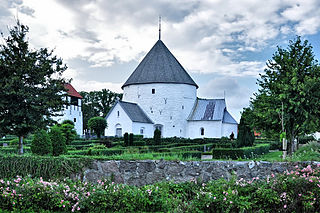
Nylars Church is a 12th-century round church in the village of Nylars near Rønne in the south of the Danish island of Bornholm. Originally designed for a defensive role, the solid structure contains a series of 13th-century frescos, the oldest of Bornholm's four round churches.
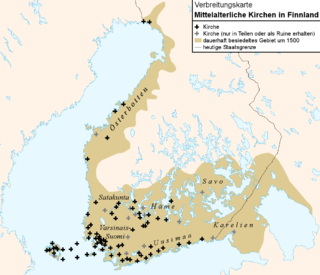
Medieval stone churches in Finland were built between the 13th and 16th century. The total number of churches was 104, of which 83 have been preserved. Numbers include the sacristies of uncompleted churches. Finnish medieval stone churches are mainly located in the western and southern parts of the country. They were usually fieldstone churches made of grey granite. Some are built of red granite and limestone while two churches are made of brick.





























